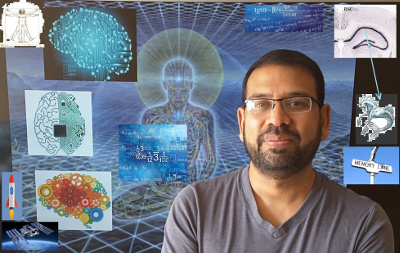
Phone: (403) 394-3951
e-mail: samsoon.inayat@uleth.ca
Research Interests
I consider memory, learning, and cognition as the most intriguing characteristics of life. I am interested in investigating how cognition emerges from memory, how memory emerges from a collection of various types of cells in the nervous system, and what makes them plastic to be able to learn. Memory is formed through the processes of learning and thus what centers of the brain mediate the processes of learning and what are the underlying mechanisms i.e. how is memory encoded in the nervous tissue? Learning happens in the awake state when novel stimuli are being entertained by the brain and thus what centers of the brain when collectively active give rise to the “awake” or “self-aware” brain state? In the awake state while in a certain situation i.e. time and place, memory is automatically recalled relevant to the current situational context, how are memories reactivated and how multiple memories are reactivated from a single clue? In order to explore such questions, I am using mouse as an animal model and investigating interactions between the hippocampus and the retrosplenial cortex while the mouse is performing tasks in a behavioral paradigm. Both, hippocampus and the retrosplenial cortex, are involved in the processes of learning and memory as well as spatial navigation. It is believed that hippocampus stores the experiences of novel stimuli in its short term memory and later mediates the transfer of data to more robust long term memory in the neocortex. Hippocampus also seems to be involved in recalling of long term memory from the neocortex when the need arises. I plan to design behavioral paradigms for mouse that would induce certain contextual memories in the hippocampal and the retrosplenial cortical neurons. I will use electrophysiology and calcium imaging to record the activity of these neurons before, during, and after the induction of memory in order to discover the relevant underlying mechanisms of memory formation, retention, and recall. Hippocampus and the retrosplenial cortex are connected together through reciprocal connections. I also plan to investigate the processes or mechanisms that are mediated by reciprocal connections.
Keywords: Neuronal correlates of behavior, Behavioral correlates of neuronal networks, Neuronal prostheses, Computational Neuroscience, Machine Learning and Artificial Intelligence.
Biography
Since my high school, I had a strong curiosity to know who we are and where did we come from? With the passage of time, I learnt that brain is part of the body that gives rise to cognition and subsequently allows us to ask such questions. Hence, I became very much interested to study brain. However, I was also interested in learning to build brain-like artificial systems that would automatically control mechanical mechanisms and processes. Based on the available educational opportunities at that time, I chose to get trained as a mechatronics engineer while learning to build robots and automatic control systems. During this time, my interest to study brain continued and therefore I joined the MS program in biomedical engineering at Northwestern University to follow my passion and work on my first neuroscience project. There, in the labs of Drs. John Troy and Lawrence Pinto, I characterized differences between mutant and wild type mouse retinas by quantifying the responses of retinal ganglion cells to visual stimulation using multielectrode array electrophysiology. In the same labs, while working towards my PhD, I developed a novel patch-clamp pipette holder which has the potential to prolong the duration of intracellular recordings from whole-cells. After finishing my PhD, I pursued two postdoctoral positions simultaneously, fulltime at Northwestern University in the lab of Dr. Jianhua Cang, and part-time at the University of Illinois-Chicago (UIC) in the lab of Dr. Laxman Saggere. At Northwestern, I studied the response properties of neurons in the mouse visual cortex and superior colliculus to visual stimulation using calcium imaging with a two-photon microscope. I also studied the development of response properties of neurons in the visual cortex by doing chronic calcium imaging. At UIC, I investigated the feasibility of retinal prostheses with chemical stimulation of retinal neurons by injecting small boluses (in nano liters) of glutamate into the retina and recording retinal ganglion cell responses using multielectrode arrays. Here at the University of Lethbridge under the mentorship of Drs. Majid Mohajerani and Bruce McNaughton, I am studying how retrosplenial cortex and hippocampus connected together with reciprocal connections interact with each other while mediating the processes of learning and memory and spatial navigation. I continue to follow my passion of studying brain and how cognition emerges as a property of the combination of a large number of cells that constitute the brain.
Education
- B.Sc. (Hons) Mechanical Engineering, University of Engineering and Technology, Taxila, Pakistan (May 2000)
- M.Sc. Mechatronics Engineering, University of Engineering and Technology, Lahore, Pakistan (September 2004)
- M.S. Biomedical Engineering, Northwestern University, Evanston, Illinois (June 2007)
- Ph.D. Biomedical Engineering, Northwestern University, Evanston, Illinois (December 2011)
Recent Publications
- S. Inayat, J. Barchini, H. Chen, L. Feng, X. Liu, and J. Cang. “Neurons in the most superficial lamina of the mouse superior colliculus are highly selective for stimulus direction”, Journal of Neuroscience, 35(20), 7992-8003, May 2015.
- S. Inayat, C. Rountree, J. B. Troy, and L. Saggere. “Chemical stimulation of rat retinal neurons: Feasibility of an epiretinal neurotransmitter-based retinal prosthesis”, Journal of Neural Engineering, 12 (2015) 016010, December 2014. (Cover Article)
- S. Inayat, L. H. Pinto and J. B. Troy, “Minimizing cytosol dilution in whole-cell patch-clamp experiments”, IEEE Transactions on Biomedical Engineering, vol. 60, no. 7, 2042-2051, July 2013. (Featured Article)
- S. Inayat, Y. Zhao, D. R. Cantrell, D. A. Dikin, L. H. Pinto and J. B. Troy, “A novel way to go whole-cell in patch clamp experiments”, IEEE Transactions on Biomedical Engineering, vol. 57, no. 11, 2764-2770, November 2010.